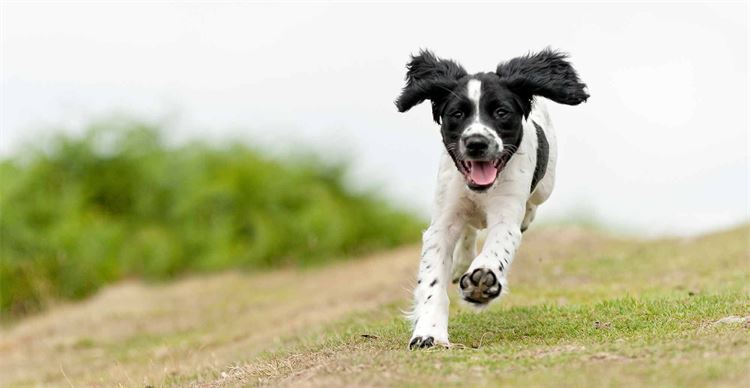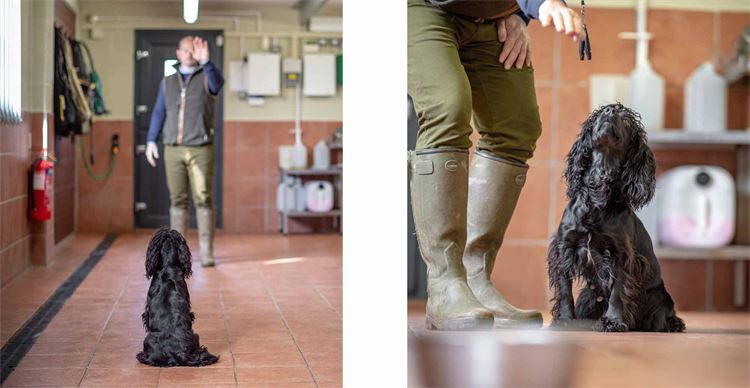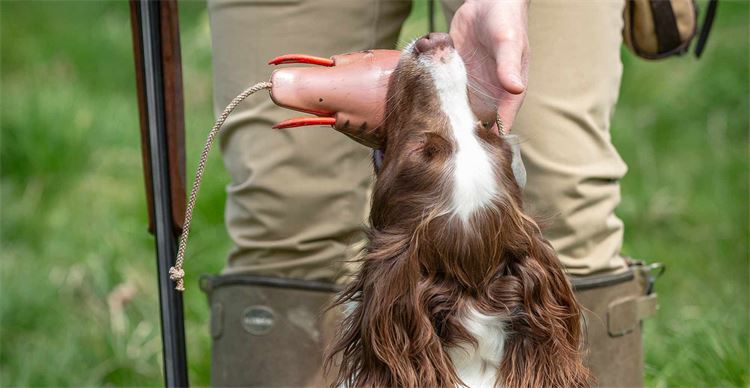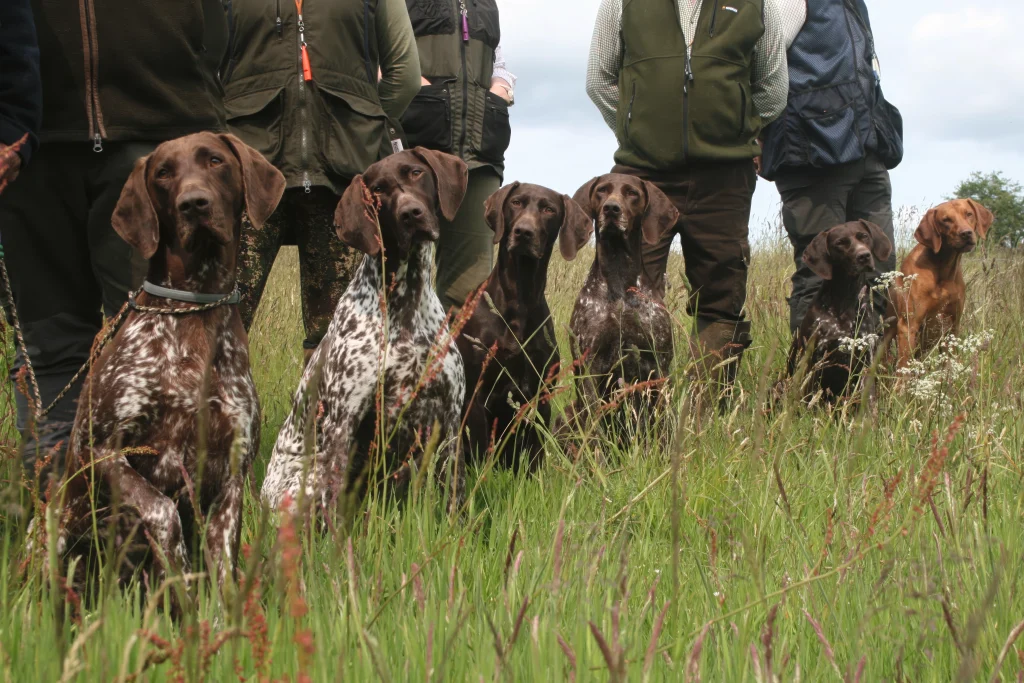Start as you mean to go on
Successful puppy training from day dot.
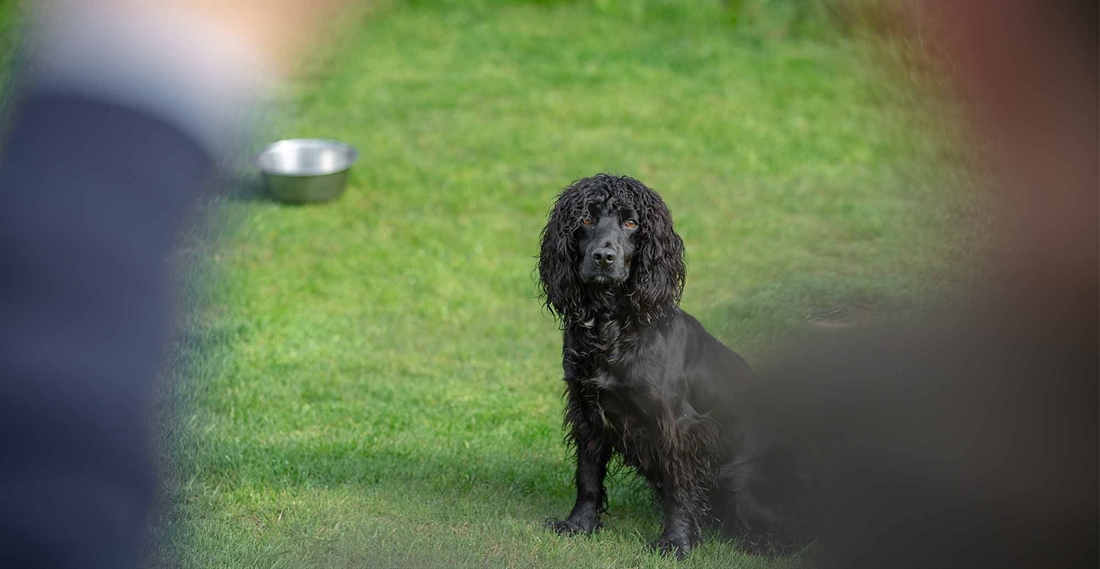
I’m often asked what the key to successful puppy training is, and my answer is always the same: start as you mean to go on, be positive, and be consistent. How many times have we heard the advice ‘just let your puppy be a puppy’? What does this even mean? For many it means letting their young dog get away with all sorts until they are 10 months old, and then struggling in an uphill battle to reverse the bad habits established during that time.
For a long time I have been well positioned to observe how dogs within a family group interact. I’ve bred numerous litters and take great interest in how the mother of each behaves around her puppies. This observation has played a key part in the development of my own training style and how I behave around a young dog that I am training; from day dot I begin building the foundations for a partnership that has respect at its core and in which the dog knows its place.
In my opinion, this relationship with your dog must begin when it is between 8–10 weeks old. And because it is in a dog’s nature to challenge your authority and status as pack leader, consistency is key. But the secret is to approach this early ‘training’ so that the dog doesn’t feel as though it is being trained – it needs to be fun and threaded into our dog’s everyday life in a subtle manner.
Dogs are trained successfully when this approach is adopted and then adhered to unwaveringly. However, in most cases, upon arriving home with their new recruit, the majority of owners fall victim to the puppy eyes, youthful exuberance and cheek of their puppy, and they largely let it get away with doing as it pleases.
So, how should we go about raising a well-behaved and responsive gundog?
Setting the boundaries
There’s nothing to say that you should not play with your pup. On the contrary, play is an important process that aids muscle development and co-ordination. But the key is for you to dictate when this takes place – it must always be on your terms, not the other way around. This is a great way to start establishing the boundaries.
Space awareness is very important, too. The puppy can interact with you and others and move into your personal ‘space’, but only when it is invited to do so. This dynamic between a puppy and its owner/other people replicates the relationship that a young dog would have with its mother.
If the pup jumps up, then a command needs to be created. Use the “leave” command with your fingers out and prod the puppy down and away from you. You must stand your ground and, if required, move towards the pup until it refrains from further negative behaviour. Then you can invite the puppy into your space when it suits you. If you observe a bitch with her young, you will notice this is how she behaves when she needs space. This interaction reminds the puppy of its place in the pecking order.
Establishing commands
All of my puppy training is 100 per cent food motivated. Once I have established the space awareness training, I build on the respectful nature of the relationship with the feeding routine. This is a positive and simple way to teach the commands that make up the foundations of all gundog training.
I feed my young dogs four times a day, which means I have four training opportunities. I will typically run through an exercise three times at each mealtime (splitting the dog’s portion of food into three for this purpose).
The recall and heelwork
From the off, mealtimes will commence with the pup sitting calmly with a lightweight ‘puppy’ slip lead over its head as I prep the food. Next, I allow the pup to drag the lead along the floor as I encourage it to follow me with gentle pips on the whistle whilst tapping my leg, walking around and saying “heel”. I repeat this at every mealtime and find it builds an incredible recall and a desire in the pup to be around me, whilst introducing it to the lead in a positive manner.
We want a young dog to associate coming to us when called with a positive experience. In the early days, at mealtimes, call the dog to you verbally (e.g. “*name*, followed by a few short pips on the whistle – I use an Acme 210.5), and reward an instant response with food. Start in an area where other distractions are few, and you will soon find the pup is eager to get to you as quickly as possible. I often use natural corridors – hallways (and later, fencelines/alleyways) to encourage a pup to come to me in a straight line from A to B.
The sit command and basic steadiness
To teach a young dog to sit, I begin by holding a food bowl above its head until it naturally sits down as it cranes its neck backwards to look up. Then, from the off, we need to teach the dog to remain sat until given further instruction. To do this, I will position the dog to my left and the food on the floor to my right. The pup will be eager to go straight to the food, hence why you are positioned between it and the food to intervene if he/she tries. The delay before issuing the “get out” command with a hand signal towards the food should be brief to start with, and then gradually increased over time.
The stop command
Once I am satisfied that the pup understands the sit (and stay until instructed otherwise) command, we can introduce the stop command. I position myself between the pup and the food so I can intervene if it does not react to my instruction. I then try stopping the pup midway to the food using a single, quiet blast on the whistle. This is followed by a brief pause and the “get out” command and hand signal, allowing the pup to go to its food. It is being rewarded for stopping and will soon learn that the sooner it stops, the sooner it will get its reward.
Directions
Teaching a pup to go left, right, forwards and backwards needn’t be onerous. The two commands we use here are “get out” and “back”. Of course, the ‘get out’ command will have been used when directing your puppy the short distance to its food in the previous stages of training, as detailed above.
To teach a pup to go straight away from you, sit him up by a wall and place a food bowl 10 yards away along the wall. Stand next to the dog and with your right arm outstretched, point along its nose and eyeline towards the bowl of food. Be accurate here; we want the dog to really learn that wherever you are pointing, he will find something. Then, in your own time, say the dog’s name, “get out” (or “back” for a retriever) and allow it to run to the bowl and eat its reward.
To teach a pup to go left or right, simply change your position in relation to the pup and use the same wall as a boundary that the pup will run along to the food bowl that has been placed either to its left or its right. With the pup sitting, raise a clear outstretched arm in one direction whilst issuing the “get out” command and allowing the pup to go to its food. Later, to mix things up, use two food bowls – one either side of the pup. This keeps him guessing and entirely focused on your body language.
The above exercises also offer the chance to teach a dog to stop at distance, on its way to the food. If the stop command has been established properly in the early stages, there should be no problems here. Still, when sending a dog away from me to food, I often follow it quietly so that when I blow the stop whistle, the dog senses my presence, realises I am directly behind it and thinks ‘Dad’s onto me – he won’t let me get away with not doing as I’m told’!
A common mistake when introducing the stop whistle at range is to blow it more than once. Only one command should be issued. If it is not obeyed, the pup should be calmly put on the lead, taken back to its position when the command was issued, and the exercise repeated. This may well take several attempts.
The leave command
A crucial weapon in the dog trainer’s arsenal, the leave command has so many applications in both the working and home environment – think food at elevenses, livestock, your neighbouring Gun’s bird that has just dropped by your peg.
To teach my pups the leave command, I start with the dog sitting and a few bits of kibble in my right hand. As I move my hand towards the dog’s nose, if he attempts to eat the food from it, I place my left hand over the his eyes and muzzle and say “leave” in a calm but firm tone. Whilst this command is given, the food is directly in front of the dog’s nose. I find that placing the palm of my hand over the pup’s eyes also has a calming effect.
Once the dog is happy to leave food in my hand, then we can progress to putting a bowl of food on the floor, directly at the dog’s feet. Here we have the chance to combine the leave command with the ‘hunt’ (“hi-lost”) command. For example, the dog will be told to leave the food when it is first placed at its feet, and then encouraged to eat the food with the verbal “hi-lost” command – later to be replaced with a drawn out low-to-high pitch whistle – after a short wait.
As the pup gets used to the leave command, it can then be incorporated into other training exercises. For example, after stopping the dog on the way to its food you might then give the “get out” or “back” command and, just as the dog reaches the food bowl, tell it to “leave” before recalling the dog back to you. You can then send the dog straight to the food as a reward. That said, I only practice this particular exercise occasionally, as it can cause very intelligent dogs or dogs that are more sensitive to become ‘sticky’ and wait for your command before picking-up a dummy further down the line.
Note: It is important to establish all of these commands in a calm, confined area. Training sessions need only last a few minutes. Once commands are being obeyed perfectly, we can then progress to another confined area outdoors with the added distractions that come with a change of environment.
Moving outdoors
I will now move outside where, importantly, the pup will be exposed to new distractions. Here we can focus on increasing the distance at which the commands established inside are given. But be aware that your pup will know that you can’t just intervene anymore! If this does not work, then the first part of the commands have not been established correctly, and you should calmly go back a stage or two and then gradually build back to the sticking point.
Dummy run
It is important to allow your puppy to develop its natural hunting and retrieving abilities, so I encourage my pups to retrieve as soon as possible. Once they have grasped the basic commands, it is time to put all the above together with a dummy. I find that I very rarely have to teach a dog to be steady to a dummy if the foundations have been thoroughly established with food. The delivery and presentation of the dummy also normally comes very naturally. As the dog gets to within a few yards of me, I tend to move towards it, into its space, and then issue the “sit” command with one hand slightly raised. This is followed by the delivery which is accompanied by the “leave” command to release the dummy.
Socialising
Socialisation is very important for a pup. This is where my wife and two boys, Joe and Jack, come into play! They spend a lot of time walking the dogs on the lead, tapping their left leg and saying “heel” as they change direction. They also take them for trips in the car as much as possible, familiarising the youngster with the vehicle and/or transit box. I would advise using one command i.e. “in” when the pup gets into the transit box, its bed or its kennel. I also take my pups into pet-friendly places where they are likely to meet people.
I continually advance these foundations through ‘patience training’, where other (obedient) dogs can be brought into the mix. I ask the pup to sit and allow other dogs to eat first before allowing the pup to have its food. This encourages the pup to focus on you as the pack leader.
In order to prevent boredom from setting in, it is important to mix things up and offer variety in its training routine at this crucial age. On this note, I also teach my spaniels (not labs at this age) to jump small nets, ditches and small streams and stay close to me in long grass, woodland etc., and I gradually introduce every type of retrieving tool I can think of – of all shapes, sizes and textures.
Summary
By the time the pup reaches six months, I have established the following commands: “Sit”; “get out” (or “back”) either for food or a retrieve (combined with left, right and back hand signals); “Heel” (tap your left leg); “*Name*, come” (for recall); “In” (for bed, car or transit box).
Importantly, if these commands can be taught with the high distraction of food, then we have a great base to build on. I find that my dogs often self-correct themselves, which suggests to me that this system/routine really does work. Finally, and perhaps most importantly, never give a command unless you are prepared to enforce it!
Commands
Sit
“sit”/ one quiet blast on the whistle
Recall
“*name*” plus multiple pips on the whistle, tap left leg
Directions
“get out” plus hand direction with outstretched arm; “back” for backwards and forwards
Leave
“leave”
Heel
“heel” plus tap left leg
Hunt
“hi-lost”/ low to high, drawn-out whistle blast.
Get in
Ben uses “in”, plus hand direction for bed, car, kennel etc.
Toilet
“toilet” plus hand direction whilst standing in one spot (the dog learns that the sooner it relieves itself, the sooner it can train).
Related Articles
Get the latest news delivered direct to your door
Subscribe to Gundog Journal
Unlock the full potential of your working dog with a subscription to Gundog Journal, the UK’s only dedicated magazine for gundog enthusiasts. Published bi-monthly, this authoritative resource delivers expert training advice, in-depth interviews with top trainers and veterinary guidance to help you nurture a stronger bond with your dog.
With stunning photography and thought-provoking content, Gundog Journal is your essential guide to understanding, training and celebrating your working dog.
Save 10% on shop price when you subscribe, with a choice of packages that work for you. Choose from Print & Digital or Digital only with each journal delivered directly to your door or via the app every other month, plus access to past issues with the digital back issue library.






